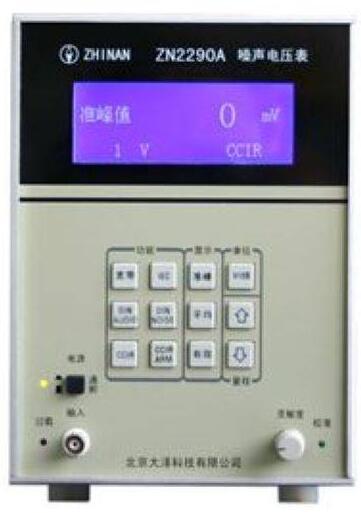ZN2290A noise voltmeter
Signal generator/distort meter
ZN2290A noise voltmeter (hereinafter referred to as the instrument) is a highly sensitive voltmeter capable of measuring AC voltage within the frequency range of 10Hz to 500KHz, and its measurement control system adopts the intelligent control of CPU.
0
0
0
发布时间: 2023-01-05 04:18:11

About:
ZN2290A noise voltmeter (hereinafter referred to as the instrument) is a highly sensitive voltmeter capable of measuring AC voltage within the frequency range of 10Hz to 500KHz, and its measurement control system adopts the intelligent control of CPU. Its voltage measurement range is 10mV ~ 300V. In addition to the commonly used average value and effective value detection, there is also peak detection weighted according to the West German DIN45405 (1967) standard and the International Radio Communication Advisory Committee CCIR (468-1, 468-2) standard.
In addition, five different standard hearing compensation weighting filters are provided for measuring noise voltage and signal-to-noise ratio. Moreover, the instrument has high sensitivity (up to 10mV) and wide measurement range, so it can measure all types of recording, playback and other audio and low-frequency equipment. It can be widely used in factories, schools and research institutes. It is especially suitable for research on audio equipment and systems and radio communication. And it has high accuracy, large input impedance, small size, convenient use, simple operation, and intuitive display. It is an electronic instrument with wide application range and strong applicability.
Characteristics:
1.1 Weighted filter
In addition to a 10Hz ~ 500KHz broadband amplifier, the instrument also provides five weighting filters of different standards.
a. DIN45405 (1967) (DIN/AUDIO)
Used for external voltage measurement, the response is a smooth curve from 10Hz to 20KHz
b. DIN45405 (1967) (DIN/NOISE)
for noise voltage measurements
c. IEC 651-A
JIS C1502A
JIS C5551A
IHF-A-202
NAB
DIN 45633
For noise voltage measurement (JISA)
d. CCIR(468-1)
CCIR(468-2)
DIN45405 (1978)
For noise voltage measurements (CCIR)
e. CCIR/ARM
IHF-A-202
For noise voltage measurement (CCIR/ARM)
1.2 Detection methods and instructions
a. DIN45405 (1967)
DIN 45405 (1978)
CCIR(468-1)
CCIR(468-2)
Sine wave RMS display uses quasi-peak detection. (quasi-peak value)
b. Sine wave RMS display uses average value detection. (average value)
c. Sine wave RMS display uses RMS detection. (valid value)
1.3 In order to measure the signal-to-noise ratio and adjust the relative level, this instrument is equipped with a sensitivity control knob with an adjustable range of approximately 0~10dB.
1.4 The instrument also has AC and DC 1V output, which can amplify the gain of 100dB at the maximum sensitivity, and can be used as a measurement amplifier or signal monitoring during measurement.
1.5 The CCIR/ARM weighting filter can automatically select the average value detection method. When using this weighting filter, it can measure the noise of the audio equipment using the Dolby noise compression circuit.
2 Rated usage range
2.1 This instrument belongs to Group II instruments in the Ministry of Electronics Industry standard SJ2075-82 "General Program for Environmental Testing of Electronic Measuring Instruments". The working environment of the instrument should avoid the influence of external electromagnetic fields and unnecessary electrical signal interference as well as strong mechanical shock and vibration.
2.2 Environmental conditions
2.2.1 Ambient temperature: 0~40℃
2.2.2 Ambient humidity: 40°C (20-90)%RH
2.2.3 Atmospheric pressure: 86~106KPa
2.2.4 Due to the large input impedance and high sensitivity of the instrument, the operating environment should try to avoid external electromagnetic fields and unnecessary electrical signal interference. The best working environment is in a shielded room.
2.2.5 There should be no excessive dust, harmful gases, and salt in the air, and strong direct sunlight should be avoided.
2.3 Power supply: 220V±10%, 50Hz±5%
2.4 Preheating time: 15 minutes
2.5 Continuous working time: more than 8 hours
2.6 Working position: Place it vertically according to the direction of the instrument panel.
2.7 Power consumption: about 15W
2.8 Overall dimensions mm: 280×160×220
2.9 Weight: about 5.5kg



